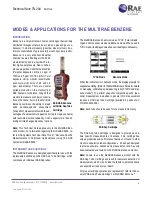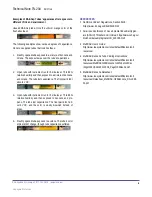
Technical Note TN-204
04/17/vk
4
Honeywell Internal
RAE Systems by Honeywell 877-723-2878 raesystems.com
Examples of RAE-Sep Tubes’ appearance after exposure to
different VOCs and environment
Unused RAE-Sep tube. Note the uniform orange color of the
fresh absorbant.
The following examples show various degrees of capacitance.
Do not use opened tubes that look like these.
1.
Freshly opened tube exposed to a mixture of benzene and
octane. The exposure was over the tube’s capacitance.
2.
Open tube with instrument run for 5 minutes at 75 to 80%
relative humidity and then exposed to a mixture of benzene
and octane. The tube lost capacitance. The front part didn’t
absorb VOC.
3.
Open tube with instrument run for 5 minutes at 75 to 80%
relative humidity and then exposed to benzene and pro-
pane. The tube lost capacitance. The front part didn’t ab-
sorb VOC, and the color is mostly brownish instead of
green.
4.
Freshly opened tube exposed to acetone. The tube’s color
almost didn’t change, though tube capacitance suffered.
REFERENCES
1 California Code of Regulations, Section 5218:
https://www.dir.ca.gov/title8/5218.html
2 American Conference of Governmental Industrial Hygien-
ists (ACGIH) Threshold Limit Value: https://www.osha.gov/
dts/chemicalsampling/data/CH_220100.html
3 MultiRAE User’s Guide:
http://www.raesystems.com/sites/default/files/content/
resources/
4 MultiRAE Benzene Tube Cartridge Instructions:
http://www.raesystems.com/sites/default/files/content/
resources/MultiRAE%20Benzene%20Tube%20Car-
tridge%20QSG%20-%20A5_Page%20RevA2.pdf
5 MultiRAE Benzene Datasheet:
http://www.raesystems.com/sites/default/files/content/
resources/Datasheet_MultiRAE-%20Benzene_DS-1098-
01.pdf






















